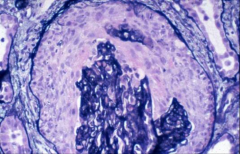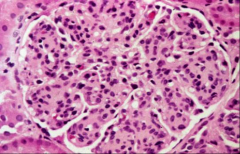![]()
![]()
![]()
Use LEFT and RIGHT arrow keys to navigate between flashcards;
Use UP and DOWN arrow keys to flip the card;
H to show hint;
A reads text to speech;
17 Cards in this Set
- Front
- Back
|
What are the three main categories of renal disease?
|
-pre-renal
-post-renal -intrinsic |
|
|
T/F Identification of a clinical renal syndrome is the same as identifying the renal disease.
|
False - multiple renal diseases can cause the same renal clinical syndrome
(biopsy tells about the renal disease) |
|
|
What kinds of molecules are more freely filtered through the GBM?
|
smaller and more positively charged
|
|
|
What cells are responsible for the synthesis of GBM?
|
Podocytes
|
|
|
Patients with nephrotic syndrome have fewer _______________ and more ________________, allowing fewer small molecules and more larger molecules than normal to be filtered.
|
small pores (from loss of filtration surface area)
large pores (from loss of slit diaphragm) |
|
|
What kind of glomerular injury is associated with nephrotic syndromes like minimal change disease and FSGS?
|
-podocyte injury (podocyte effacement)
|
|
|
FSGS is associated with ____________ in renal mass.
|
decrease
|
|
|
Two forms of immune glomerular injury
|
-subepithelial
-subendothelial/mesangial |
|
|
Which is associated with nephrotic syndrome? Which is associated with nephritic syndrome?
|
-subepithelial - nephrotic
-subendothelial - nephritic |
|
|
Which is not associated with hypercellularity?
|
Subepithelial - outside the GBM so not associated with leukocyte infiltration and hypercellularity, instead see capillary wall thickening
|
|
|
Anti-GBM disease will show what pattern of IF? What are the antibodies generated to?
|
-Linear
-A3 portion of the type IV collagen |
|

What kind of glomerular damage is shown here?
|
subepithelial
|
|

What is shown here that can be a result of anti-GBM disease?
|
crescent formation
|
|

Glomerular damage of the type shown is associated with ____________ syndrome.
|
nephritic
(subendothelial damage - note hypercellularity) |
|
|
Progressive glomerular injury leads to __________________, at which point the mechanism of injury is no longer identifiable
|
global glomerulosclerosis
|
|
|
Podocyte injury can lead to what laboratory finding?
|
Proteinuria
|
|
|
T/F Podocytes are terminally differentiated and do not replicate
|
True
|

